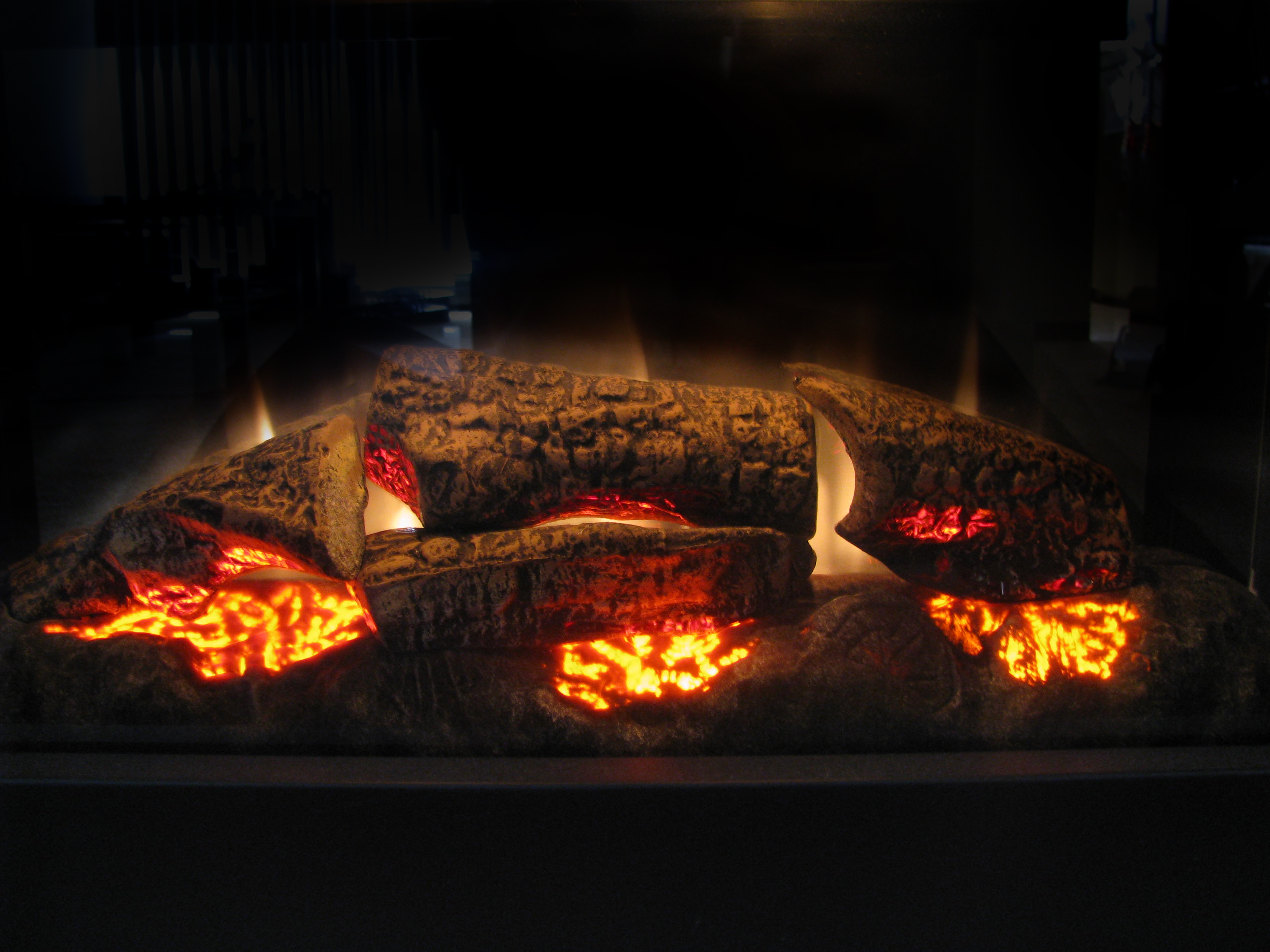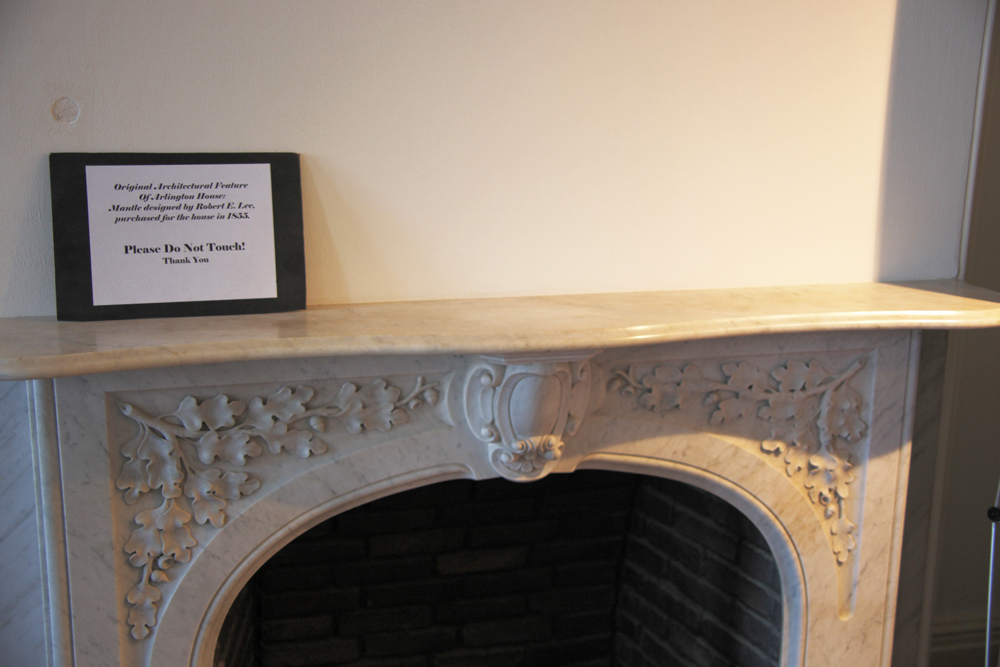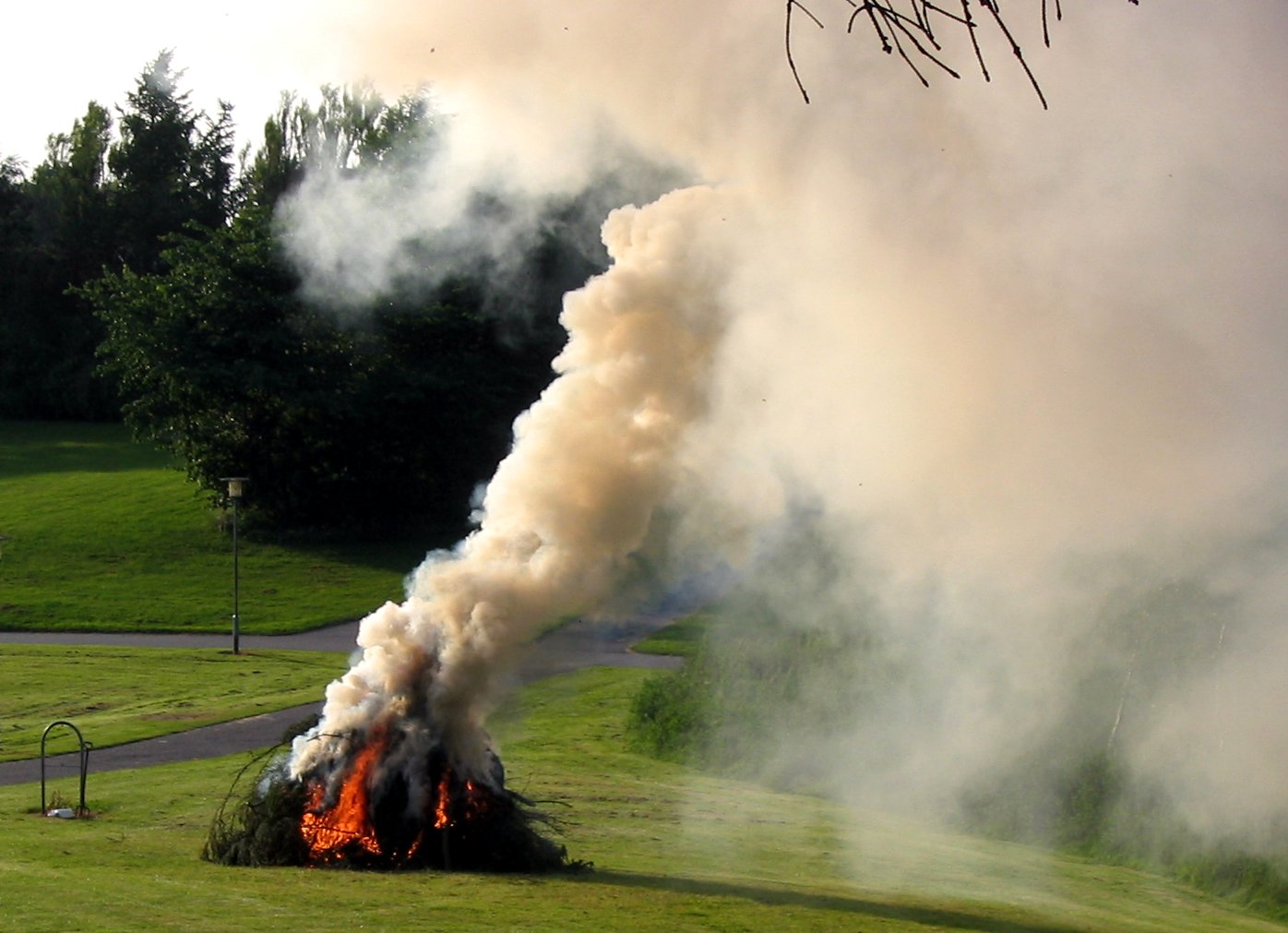|
Fireplace
A fireplace or hearth is a structure made of brick, stone or metal designed to contain a fire. Fireplaces are used for the relaxing ambiance they create and for heating a room. Modern fireplaces vary in heat efficiency, depending on the design. Historically, they were used for heating a dwelling, cooking, and heating water for laundry and domestic uses. A fire is contained in a firebox or fire pit; a chimney or other flue allows exhaust gas to escape. A fireplace may have the following: a foundation, a hearth, a firebox, a mantel, a chimney crane (used in kitchen and laundry fireplaces), a grate, a lintel, a lintel bar, an overmantel, a damper, a smoke chamber, a throat, a flue, and a chimney filter or afterburner. On the exterior, there is often a corbelled brick crown, in which the projecting courses of brick act as a drip course to keep rainwater from running down the exterior walls. A cap, hood, or shroud serves to keep rainwater out of the exterior of the chimne ... [...More Info...] [...Related Items...] OR: [Wikipedia] [Google] [Baidu] |
Wood Fuel
Wood fuel (or fuelwood) is a fuel such as firewood, charcoal, chips, sheets, pellets, and sawdust. The particular form used depends upon factors such as source, quantity, quality and application. In many areas, wood is the most easily available form of fuel, requiring no tools in the case of picking up dead wood, or few tools, although as in any industry, specialized tools, such as skidders and hydraulic wood splitters, have been developed to mechanize production. Sawmill waste and construction industry by-products also include various forms of lumber tailings. The discovery of how to make fire for the purpose of burning wood is regarded as one of humanity's most important advances. The use of wood as a fuel source for heating is much older than civilization and is assumed to have been used by Neanderthals. Today, burning of wood is the largest use of energy derived from a solid fuel biomass. Wood fuel can be used for cooking and heating, and occasionally for fueling st ... [...More Info...] [...Related Items...] OR: [Wikipedia] [Google] [Baidu] |
Electric Fireplace
An electric fireplace is an electric heater that mimics a fireplace burning coal, wood, or natural gas. Electric fireplaces are often placed in conventional fireplaces, which can then no longer be used for conventional fires. They plug into the wall, and can run on a "flame only" setting, or can be used as a heater, typically consuming 1.4-1.6 kW, that can heat a room. History The electric fire was invented in 1912 and became popular in the 1950s. Techniques for electrical "flame effects" have been around since at least 1981. Commercial electric fireplace techniques include the Optiflame, introduced in 1988 by Dimplex. Dimplex claims to have produced the first electric fireplace with a "realistic" wood-burning flame effect in 1995. It is unclear what specific technique is being referred to, although it may be . In 2008 Dimplex launched the Opti-myst effect which simulates both flames and smoke. In 2013 Dimplex launched the Opti-V effect which combines realistic fli ... [...More Info...] [...Related Items...] OR: [Wikipedia] [Google] [Baidu] |
Overmantel
The fireplace mantel or mantelpiece, also known as a chimneypiece, originated in medieval times as a hood that projected over a fire grate to catch the smoke. The term has evolved to include the decorative framework around the fireplace, and can include elaborate designs extending to the ceiling. ''Mantelpiece'' is now the general term for the jambs, mantel shelf, and external accessories of a fireplace. For many centuries, the ''chimneypiece'' was the most ornamental and most artistic feature of a room, but as fireplaces have become smaller, and modern methods of heating have been introduced, its artistic as well as its practical significance has lessened. Where the fireplace continues up the wall with an elaborate construction, as in historic grand buildings, this is known as an overmantel.''OED'' first citation, 1882. Mirrors and paintings designed to be hung above a mantel shelf may be called "mantel mirror", "mantel painting" and so on. History Up to the twelfth century, ... [...More Info...] [...Related Items...] OR: [Wikipedia] [Google] [Baidu] |
Firebox (architecture)
A firebox or firepit is the part of the fireplace where fuel is combusted, in distinction from the hearth, chimney, mantel, overdoor and flue elements of the total fireplace system. The firebox normally sits on a masonry base at the floor level of the room. Some fireboxes are large in proportion so that a person could actually walk inside, or in extreme cases have a small meeting using built-in benches inside. An example of the latter oversize construction can be found in the great hall of Muchalls Castle in Scotland. See also *Andiron An andiron or firedog, fire-dog or fire dog is a bracket support, normally found in pairs, on which logs are laid for burning in an open fireplace, so that air may circulate under the firewood, allowing better burning and less smoke. They gene ... *'' Agungi'' Fireplaces {{Architecturalelement-stub ... [...More Info...] [...Related Items...] OR: [Wikipedia] [Google] [Baidu] |
Flue
A flue is a duct, pipe, or opening in a chimney for conveying exhaust gases from a fireplace, furnace, water heater, boiler, or generator to the outdoors. Historically the term flue meant the chimney itself. In the United States, they are also known as vents for boilers and as breeching for water heaters and modern furnaces. They usually operate by buoyancy, also known as the stack effect, or the combustion products may be 'induced' via a blower. As combustion products contain carbon monoxide and other dangerous compounds, proper 'draft', and admission of replacement air is imperative. Building codes, and other standards, regulate their materials, design, and installation. Heat retention Flues are adjustable and are designed to release noxious gases to the atmosphere. They often have the disadvantageous effect of releasing useful household heat to the atmosphere when not properly set—the very opposite of why the fire was lit in the first place. Fireplaces are one of ... [...More Info...] [...Related Items...] OR: [Wikipedia] [Google] [Baidu] |
Chimney Crane
Chimney cranes, also known as fireplace cranes and pot cranes, are a feature of the homes of the American Colonial period and 18/19th century of Western Europe. Although the chimney crane may be thought by some to be a Yankee invention, it was common in both British and American houses of the era. The purpose of the crane is to allow a cooking pot to be swung away from the fire, preventing burn injuries to the cook as well as regulating temperature of the pot. The chimney crane is an important step in open hearth cooking as it helped save lives and allowed cooks to be more creative. For centuries before the iron crane was introduced, colonial and European fireplace A fireplace or hearth is a structure made of brick, stone or metal designed to contain a fire. Fireplaces are used for the relaxing ambiance they create and for heating a room. Modern fireplaces vary in heat efficiency, depending on the desig ...s used a chain that hung from first a green wooden chimney lug pol ... [...More Info...] [...Related Items...] OR: [Wikipedia] [Google] [Baidu] |
Hearth
A hearth () is the place in a home where a fire is or was traditionally kept for home heating and for cooking, usually constituted by at least a horizontal hearthstone and often enclosed to varying degrees by any combination of reredos (a low, partial wall behind a hearth), fireplace, oven, smoke hood, or chimney. Hearths are usually composed of masonry such as brick or stone. For centuries, the hearth was such an integral part of a home, usually its central and most important feature, that the concept has been generalized to refer to a homeplace or household, as in the terms "hearth and home" and "keep the home fires burning". In the modern era, since the advent of central heating, hearths are usually less central to most people's daily life because the heating of the home is instead done by a furnace or a heating stove, and cooking is instead done with a kitchen stove/range (combination cooktop and oven) alongside other home appliances; thus many homes built in the 20t ... [...More Info...] [...Related Items...] OR: [Wikipedia] [Google] [Baidu] |
Fire Pit
A fire pit or a fire hole can vary from a pit dug in the ground to an elaborate gas burning structure of stone, brick, and metal. The defining feature of fire pits is that they are designed to contain fire and prevent it from spreading. Some recent fire pits have a fire bowl that can be placed in the ground or on legs. Contemporary types Pre-made fire pits are the most common form of fire pits and can be purchased from a store. These are commonly made of pre cast concrete or metal or a combination of metal table and stone. They burn usually natural gas, propane (LP) or bio ethanol. Wood burning fire pits made of metal are also quite common but under increasing scrutiny due to fire bans and air particulate emissions. Natural gas and propane burners in these sort of pre fabricated vessels are certified under ANSI (American), CSA (Canadian) and CE (European) standards. Unregulated and uncertified fire pit burners are increasingly being scrutinized by regulatory authorities and ... [...More Info...] [...Related Items...] OR: [Wikipedia] [Google] [Baidu] |
Smoke
Smoke is a suspension of airborne particulates and gases emitted when a material undergoes combustion or pyrolysis, together with the quantity of air that is entrainment (engineering), entrained or otherwise mixed into the mass. It is commonly an unwanted by-product of fires (including stoves, candles, internal combustion engines, oil lamps, and fireplaces), but may also be used for pest control (fumigation), communication (smoke signals), defensive and offensive capabilities in the military (smoke screen), Smoking (cooking), cooking, or smoking (tobacco smoking, tobacco, cannabis (drug), cannabis, etc.). It is used in rituals where incense, Salvia officinalis, sage, or resin is burned to produce a smell for spiritual or magical purposes. It can also be a flavoring agent and preservative. Smoke inhalation is the primary cause of death in victims of indoor fires. The smoke kills by a combination of thermal damage, poisoning and lung, pulmonary irritation caused by carbon mo ... [...More Info...] [...Related Items...] OR: [Wikipedia] [Google] [Baidu] |
Lintel
A lintel or lintol is a type of beam (a horizontal structural element) that spans openings such as portals, doors, windows and fireplaces. It can be a decorative architectural element, or a combined ornamented structural item. In the case of windows, the bottom span is instead referred to as a sill, but, unlike a lintel, does not serve to bear a load to ensure the integrity of the wall. Modern day lintels are made using prestressed concrete and are also referred to as beams in beam and block slabs or ribs in rib and block slabs. These prestressed concrete lintels and blocks are components that are packed together and propped to form a suspended floor concrete slab. Structural uses In worldwide architecture of different eras and many cultures, a lintel has been an element of post and lintel construction. Many different building materials have been used for lintels. In classical Western architecture and construction methods, by ''Merriam-Webster'' definition, a lintel is ... [...More Info...] [...Related Items...] OR: [Wikipedia] [Google] [Baidu] |
Dwelling
In law, a dwelling (also known as a residence or an abode) is a self-contained unit of accommodation used by one or more households as a home - such as a house, apartment, mobile home, houseboat, vehicle, or other "substantial" structure. The concept of a dwelling has significance in relation to search and seizure, conveyancing of real property, burglary, trespass, and land-use planning. Legal definitions Legal definitions vary by jurisdiction. 'Dwelling' (England and Wales) Under English law, a dwelling is defined as a self-contained 'substantial' unit of accommodation, such as a building, part of a building, caravan, houseboat or other mobile home. A tent is not normally considered substantial. 'Dwelling' (North Carolina) According to North Carolina General Statute § 160A-442, "Dwelling" means any building, structure, manufactured home or mobile home, or part thereof, used and occupied for human habitation, or intended to be so used, and includes any outhouses and a ... [...More Info...] [...Related Items...] OR: [Wikipedia] [Google] [Baidu] |





